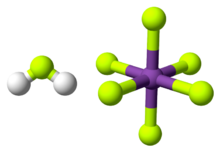Chemistry:Fluoroantimonic acid

| |

| |
 Fluoroantimonic acid stored in a PFA bottle
| |
| Names | |
|---|---|
| IUPAC name
Fluoroantimonic acid
| |
| Systematic IUPAC name
Hexafluoroantimonic acid | |
Other names
| |
| Identifiers | |
| |
3D model (JSmol)
|
|
| ChemSpider | |
| EC Number |
|
PubChem CID
|
|
| |
| |
| Properties | |
| Appearance | Colorless fuming liquid |
| Density | 2.885 g/cm3 |
| Boiling point | 40 °C (104 °F; 313 K) (decomposes) |
| Reacts explosively | |
| Solubility | SO2ClF, SO2 |
| Hazards | |
| Main hazards | extremely corrosive, toxic, violent hydrolysis, oxidizer |
| GHS pictograms |      
|
| GHS Signal word | Danger |
| H300+310+330Script error: No such module "Preview warning".Category:GHS errors, H314, H411, H350, H410, H441Script error: No such module "Preview warning".Category:GHS errors, H240, H271, H290 | |
| P260, P264, P273, P280, P284, P301+310 | |
| NFPA 704 (fire diamond) | |
| Related compounds | |
Related acids
|
Antimony pentafluoride Hydrogen fluoride Magic acid |
Except where otherwise noted, data are given for materials in their standard state (at 25 °C [77 °F], 100 kPa). | |
| Infobox references | |
Fluoroantimonic acid is a mixture of hydrogen fluoride and antimony pentafluoride, containing various cations and anions (the simplest being H2F+ and Sb F−6). This mixture is a superacid that, in terms of corrosiveness, is trillions of times stronger than 100% sulfuric acid in terms of its protonating ability measured by Hammett function. It even protonates some hydrocarbons to afford pentacoordinate carbocations (carbonium ions).[1] Like its precursor hydrogen fluoride, it attacks glass, but can be stored in containers lined with PTFE (Teflon) or PFA.
Chemical composition
Fluoroantimonic acid is formed by combining hydrogen fluoride and antimony pentafluoride:
- SbF5 + 2 HF ⇌ SbF−6 + H2F+
The speciation (i.e., the inventory of components) of "fluoroantimonic acid" is complex. Spectroscopic measurements show that fluoroantimonic acid consists of a mixture of HF-solvated protons, [(HF)
nH]+
(such as H
3F+
2), and SbF5-adducts of fluoride, [(SbF5)nF]– (such as Sb
4F−
21). Thus, the formula "[H
2F]+
[SbF
6]−
" is a convenient but oversimplified approximation of the true composition.[2] Nevertheless, the extreme acidity of this mixture is evident from the exceptionally poor proton-accepting ability of the species present in solution. Hydrogen fluoride, a weak acid in aqueous solution that is normally not thought to have any appreciable Brønsted basicity at all, is in fact the strongest Brønsted base in the mixture, protonating to H2F+ in the same way water protonates to H3O+ in aqueous acid. As a result, the acid is often said to contain "naked protons", though the "free" protons are, in fact, always bonded to hydrogen fluoride molecules.[3] It is the fluoronium ion that accounts for fluoroantimonic acid's extreme acidity. The protons easily migrate through the solution, moving from H2F+ to HF, when present, by the Grotthuss mechanism.
Two related products have been crystallized from HF-SbF5 mixtures, and both have been analyzed by single crystal X-ray crystallography. These salts have the formulas [H2F+] [Sb2F−11] and [H3F+2] [Sb2F−11]. In both salts, the anion is Sb2F−11.[4] As mentioned above, SbF−6 is weakly basic; the larger anion Sb2F−11 is expected to be a still weaker base.
Acidity
Fluoroantimonic acid is the strongest superacid based on the measured value of its Hammett acidity function (H0), which has been determined for various ratios of HF:SbF5. The H0 of HF is −15. A solution of HF containing 1 mol % of SbF5 is −20. The H0 is −21 for 10 mol%. For > 50 mol % SbF5, the H0 is between −21 and −23. The lowest attained H0 is about -28.[5][6][7] The following H0 values show that fluoroantimonic acid is stronger than other superacids.[8] Increased acidity is indicated by smaller (in this case, more negative) values of H0.
- Fluoroantimonic acid (−23 > H0 > −28)
- Magic acid (H0 = −23)
- Carborane acid (H0 < −18)
- Fluorosulfuric acid (H0 = −15)
- Triflic acid (H0 = −15)
- Perchloric acid (H0 = −13)
Of the above, only the carborane acids, whose H0 could not be directly determined due to their high melting points, may be stronger acids than fluoroantimonic acid.[8][9]
The H0 value measures the protonating ability of the bulk, liquid acid, and this value has been directly determined or estimated for various compositions of the mixture. The pKa on the other hand, measures the equilibrium of proton dissociation of a discrete chemical species when dissolved in a particular solvent. Since fluoroantimonic acid is not a single chemical species, its pKa value is not well-defined.[citation needed]
The gas-phase acidity (GPA) of individual species present in the mixture have been calculated using density functional theory methods.[2] (Solution-phase pKas of these species can, in principle, be estimated by taking into account solvation energies, but do not appear to be reported in the literature as of 2019.) For example, the ion-pair [H2F]+·SbF–6 was estimated to have a GPA of 254 kcal/mol. For comparison, the commonly encountered superacid triflic acid, TfOH, is a substantially weaker acid by this measure, with a GPA of 299 kcal/mol.[10] However, certain carborane superacids have GPAs lower than that of [H2F]+·SbF–6. For example, H(CHB11Cl11) has an experimentally determined GPA of 241 kcal/mol.[11]
Reactions
Fluoroantimonic acid solution is so reactive that it is challenging to identify media with which it is unreactive. Materials compatible with fluoroantimonic acid as a solvent include SO2ClF, and sulfur dioxide; some chlorofluorocarbons have also been used. Containers for HF/SbF5 are made of PTFE.[citation needed]
Fluoroantimonic acid solutions decompose when heated, generating free hydrogen fluoride gas and liquid antimony pentafluoride at a temperature of 40 °C.[12]
As a superacid, fluoroantimonic acid solutions protonate nearly all organic compounds, often causing dehydrogenation, or dehydration. In 1967, Bickel and Hogeveen showed that 2HF·SbF5 reacts with isobutane and neopentane to form carbenium ions:[13][14]
- (CH3)3CH + H+ → (CH3)3C+ + H2
- (CH3)4C + H+ → (CH3)3C+ + CH4
It is also used in the synthesis of tetraxenonogold complexes.[15]
Safety
HF/SbF5 is a highly corrosive substance that reacts violently with water. Heating it is dangerous as well, as it decomposes into toxic hydrogen fluoride gas. With superacids that are fuming and toxic, proper personal protective equipment should be used. In addition to the obligatory gloves and goggles, the use of a face shield and respirator are also required. Regular lab gloves are not recommended, as this acid can react with the gloves.[9] Safety gear must be worn at all times when handling or going anywhere near this corrosive substance, as fluoroantimonic acid can protonate every compound in the human body.[16]
See also
References
- ↑ Olah, G. A. (2001). A Life of Magic Chemistry: Autobiographical Reflections of a Nobel Prize Winner. John Wiley and Sons. pp. 100–101. ISBN 978-0-471-15743-4.
- ↑ 2.0 2.1 Esteves, Pierre M.; Ramírez-Solís, Alejandro; Mota, Claudio J. A. (March 2002). "The Nature of Superacid Electrophilic Species in HF/SbF5: A Density Functional Theory Study". Journal of the American Chemical Society 124 (11): 2672–2677. doi:10.1021/ja011151k. ISSN 0002-7863. PMID 11890818.
- ↑ Klein, Michael L. (October 25, 2000). "Getting the Jump on Superacids". Pittsburgh Supercomputing Center (PSC). http://www.psc.edu/science/Klein2000/getting_jump_on_superacids.pdf.
- ↑ Mootz, Dietrich; Bartmann, Klemens (March 1988). "The Fluoronium Ions H2F+ and H3F+2: Characterization by Crystal Structure Analysis". Angewandte Chemie International Edition 27 (3): 391–392. doi:10.1002/anie.198803911.
- ↑ Superacid chemistry. Olah, George A. (George Andrew), 1927–2017., Olah, George A. (George Andrew), 1927–2017. (2nd ed.). Hoboken, N.J.: Wiley. 2009. ISBN 9780470421543. OCLC 391334955.
- ↑ Olah, G. A. (2005). "Crossing Conventional Boundaries in Half a Century of Research". Journal of Organic Chemistry 70 (7): 2413–2429. doi:10.1021/jo040285o. PMID 15787527.
- ↑ It has been estimated that HF-SbF5 mixtures have H0 values as low as –28. H0 values down to –27 have been estimated for FSO3H-SbF5 at 90% SbF5, but other measurements do not support H0 values lower than about –24 for either magic acid or fluoroantimonic acid.
- ↑ 8.0 8.1 Gillespie, R. J.; Peel, T. E. (1973-08-01). "Hammett acidity function for some superacid systems. II. Systems sulfuric acid-[fsa], potassium fluorosulfate-[fsa], [fsa]-sulfur trioxide, [fsa]-arsenic pentafluoride, [sfa]-antimony pentafluoride and [fsa]-antimony pentafluoride-sulfur trioxide". Journal of the American Chemical Society 95 (16): 5173–5178. doi:10.1021/ja00797a013. ISSN 0002-7863.
- ↑ 9.0 9.1 Olah, G. A.; Prakash, G. K. Surya; Wang, Qi; Li, Xing-ya (15 April 2001). "Hydrogen Fluoride–Antimony(V) Fluoride". Encyclopedia of Reagents for Organic Synthesis. New York: John Wiley and Sons. doi:10.1002/047084289X.rh037m. ISBN 9780470842898. http://onlinelibrary.wiley.com/o/eros/articles/rh037m/frame.html.
- ↑ Koppel, Ilmar A.; Burk, Peeter; Koppel, Ivar; Leito, Ivo; Sonoda, Takaaki; Mishima, Masaaki (May 2000). "Gas-Phase Acidities of Some Neutral Brønsted Superacids: A DFT and ab Initio Study" (in en). Journal of the American Chemical Society 122 (21): 5114–5124. doi:10.1021/ja0000753. ISSN 0002-7863.
- ↑ Meyer, Matthew M.; Wang, Xue-bin; Reed, Christopher A.; Wang, Lai-Sheng; Kass, Steven R. (2009-12-23). "Investigating the Weak to Evaluate the Strong: An Experimental Determination of the Electron Binding Energy of Carborane Anions and the Gas phase Acidity of Carborane Acids" (in en). Journal of the American Chemical Society 131 (50): 18050–18051. doi:10.1021/ja908964h. ISSN 0002-7863. PMID 19950932. https://escholarship.org/uc/item/5qv4v9pn.
- ↑ Oelderik, Jan (December 1966). "Werkwijze ter bereiding van halogeenverbindingen van vijfwaardig antimoon". Netherlands Patent Application NL 6508096 A.
- ↑ Bickel, A. F.; Gaasbeek, C. J.; Hogeveen, H.; Oelderik, J. M.; Platteeuw, J. C. (1967). "Chemistry and spectroscopy in strongly acidic solutions: reversible reaction between aliphatic carbonium ions and hydrogen". Chemical Communications 1967 (13): 634–635. doi:10.1039/C19670000634.
- ↑ Hogeveen, H.; Bickel, A. F. (1967). "Chemistry and spectroscopy in strongly acidic solutions: electrophilic substitution at alkane-carbon by protons". Chemical Communications 1967 (13): 635–636. doi:10.1039/C19670000635.
- ↑ Konrad Seppelt, Stefan Seidel; Seppelt, K (2000-10-06). "Xenon as a Complex Ligand: The Tetraxenonogold(II) Cation in AuXe2+4(Sb2F−11)2". Science 290 (5489): 117–118. doi:10.1126/science.290.5489.117. PMID 11021792. Bibcode: 2000Sci...290..117S.
- ↑ "What Is the World's Strongest Superacid?". ThoughtCo. https://www.thoughtco.com/the-worlds-strongest-superacid-603639.
 |

